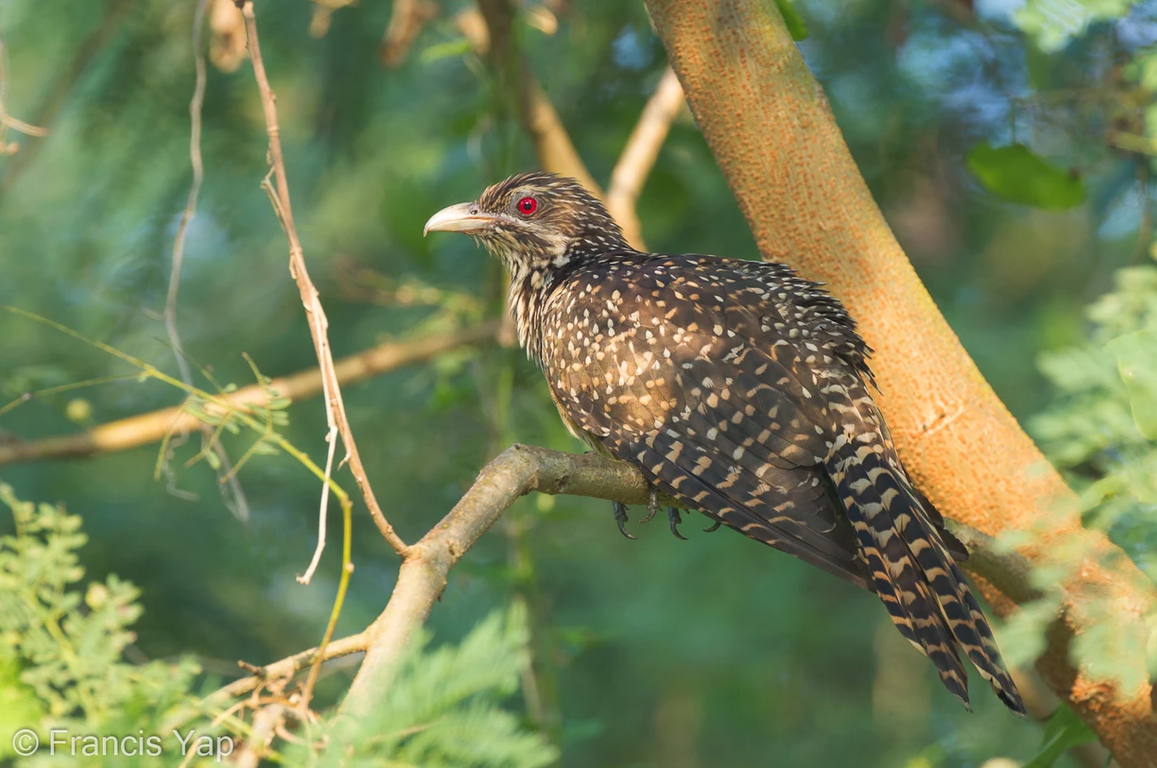The ‘uwu bird’ and its distinctive call seems to evoke two very different kinds of reactions amongst Singaporeans: either the tranquillity and hope for the new day ahead, or immense annoyance that your precious sleep has been interrupted.
Personally, it feels like I’m studying for my A Levels all over again, only realising it is dawn when I hear its call. In other words, trauma.
Love them or hate them, however, the sounds of this bird have become a quintessential part of the Singaporean daily life and culture, but there is always more to this bird than meets the eye (even if we can barely see them).
So strap in, and learn ten new things about the Asian Koel!
1) They are a Native Species to Singapore
Asian Koels (also known as Eudynamys scolopaceus), is native to China, South Asia, and Southeast Asia. They first arrived in Singapore in the 1980s and inhabit Singapore’s secondary forests, parks, and low-density urban regions.
According to BirdLife International 2016, the Asian Koel is classified under ‘Least Concern’ in regards to their conservation status, and though they are elusive little creatures, they are pretty commonly found all over our island.
Other than that one tree outside your HDB window, Asian Koels thrive in various suitable habitats like Singapore Botanic Gardens, Pasir Ris Park, Lorong Halus, Sungei Buloh Wetland Reserve, Kranji Marsh, Jurong Eco Garden, and more.
2) They Get their Name from the Sound They Make
The term “koel” originates from onomatopoeia, which is a fancy word for a name that phonetically imitates, resembles, or suggests the sound that it describes.
Think Pikachu from Pokemon, which is a combination of Japanese words pika-pika, the sound of sparkling, and chu, which is the sound a mouse makes.
In our case, Asian Koels get their name because, well, their call sounds like “ko-el”.
(Come to think of it, if Gen Z had been the ones to discover it, would we have actually named it the Uwu Bird..?)
On the other hand, genus name Eudynamys originates from Ancient Greek, where “eu” signifies “fine” and “dunamis” denotes “power” or “strength.” Scolopaceus is derived from Modern Latin, meaning “snipe-like,” derived from the Latin word “scolopax,” which refers to a “snipe” or “woodcock”, two birds with distinctively long bills.
So, Eudynamys scolopaceus essentially means a long-billed bird with fine strength.
3) They are Widely Revered in Asian Folklore and Culture
Though they may be annoying to a few, Asian Koels are actually held in pretty high regard in Asian folklore, making appearances in poems, art and stories.
Across numerous cultures, the Asian Koel is linked to supernatural abilities and symbolises love, fertility, and prosperity. In India, it’s seen as a harbinger of good fortune for lovers, its call likened to the heartbeat of a beloved.
Sri Lankans view it as a divine messenger and guardian of crops.
The Asian Koels are also celebrated in Nepali cultures as they symbolise rebirth and regeneration to the predominantly Hindu and Buddhist communities in the Himalayan nation.
Moreover, it plays a role in traditional knowledge systems, especially in agriculture. Its call often signals the timing of planting and harvesting in certain cultures. Additionally, its behavior and habits are sometimes used to forecast weather and environmental changes.
4) They are Closely Related to the Cuckoo Bird
The Asian Koel belongs to the cuckoo order of birds, Cuculiformes, and is closely related to other birds like the Black-billed Koels and Pacific Koels, so much so that some people think they are the same.
However, because of their biological differences, primarily in plumage, bill colour, and voice, many scientists now consider them separate species.
For example, some think the Black-billed Koel is its own species, while others think the Asian Koel includes all types except the ones found in Australia, which have their own name: the Australian Koel.
5) They are More Often Heard than Seen
Spotting Asian Koels can be challenging because they tend to hide behind thick foliage high up in trees. They are described to be extremely shy, secretive yet smart birds and prefer to perch out of sight.
As a result, they stay safe from both humans and natural predators.
Though they are difficult to spot, they make their presence known throughout the whole neighbourhood with their loud, distinctive calls.
6) The Males and the Females Look and Behave Differently
Unlike many birds you commonly see in Singapore, the Asian Koel exhibit what is known as sexual dimorphism, whereby there are the differences in appearance between males and females of the same species, such as in colour, shape, size, and structure.
In general, Asian Koels can reach sizes of up to 46CM and have a lifespan of 12 to up to 15 years in captivity (though, you can’t keep them as pets in Singapore unless you want to be slapped with a hefty fine and annoy all your neighbours in the process).
Male Asian Koels display glossy blue-black feathers, crimson irises, long tails, pale green beaks, and grey legs and feet.

In contrast, females have dark brown upperparts and light brown underparts, with heavily spotted and streaked bodies in white and rufous.

However, both male and females sport the same crimson red eyes that seem to stare into one’s very soul.
7) They Actually Have More Than One Call
The Asian Koel are able to produce various kinds of calls, all of which you probably might have heard before.
Like how humans have different tones in their voice to convey their moods, the Asian Koel has different calls for various uses, from basic communication to reacting to intruders.
The most distinctive “ko-el” call (or “uwu”, if it floats your boat better) actually only comes from the male bird, acting as a mating call to attract the female species. As such, these calls are most often heard during the breeding season (roughly every 3 months throughout the year, following the house crow, more reasons on that later), and sometimes it can last throughout the night.
So, yes, the next time you’re “uwu”-ing in response to the bird nesting in your neighbourhood, please remember that you’re acting as its competitor to attract a female bird, and maybe reevaluate your priorities a little.
The female, on the other hand, makes a more shrill and distinctive kik-kik-kik call.
8) They are Omnivorous
If you paid attention in Primary 3 science, you would remember that the word means that the animal eats both plants and animals.
More specifically, the Asian Koel start off feeding on insects and berries, but as they mature and grow, they switch to a primarily frugivorous diet, a trait that sets them apart from their cuckoo cousins.
Hence, if you have a fruit tree near your home, that is probably why you keep hearing them.
They have been known to be extremely protective of their food sources, chasing away other birds and small animals.
9) They are a Brood Parasite
Here’s where things get a little less Disney Channel-family friendly and a bit more like National Geographic.
Asian Koels are actually brood parasites. This behaviour means that female Asian Koels don’t construct their own nests; instead, they lay eggs in the nests of other birds, relying on the host birds to raise their young. Common hosts for Asian Koels in Singapore include House Crows and Javan Mynas, which share the same habitat.
Young Koels often hatch before their host’s offspring and may sometimes push out the host’s eggs from the nest.
Kinda morbid huh? That’s like the Orphan movie but in bird.
While many cuckoos mimic their host’s egg patterns, a 2021 study found that Asian Koels’ eggs remain notably distinct from their hosts’, indicating a lack of evolutionary mimicry.
Huh, if they’re as common as you said they are, how are they still protected?
In Singapore, the Asian Koel is safeguarded by the Wildlife Act due to its protected status. Brood parasitism by koels plays a role in controlling the population of crows by reducing their reproductive success.
Moreover, their frugivorous nature makes them play a key ecological role in dispersing the seeds of fruits they consume.
The National Parks Board (NParks) received an average of 640 feedback cases about Asian koels annually from 2016 to 2020, comprising around 4% of total feedback.
NParks collaborates with town councils and estate managers to prune trees and remove fruits to deter the birds from perching or foraging.
Additionally, NParks removes crow nests, as Asian koels lay their eggs in them, effectively managing their population in residential areas sustainably and humanely.
NParks plans to enhance its strategies to mitigate bird-related issues while promoting coexistence with native wildlife.
For assistance, individuals can use the online feedback form on the AVS website or contact their town council or condominium management.



